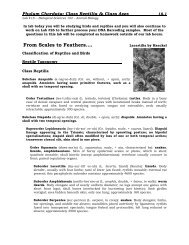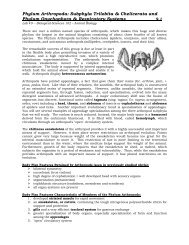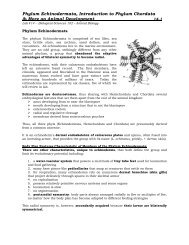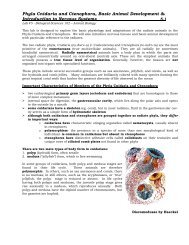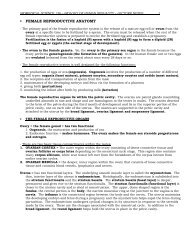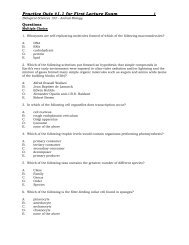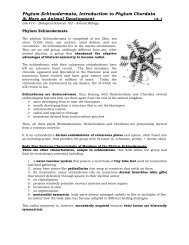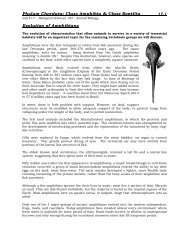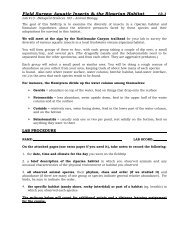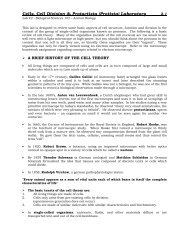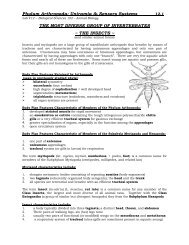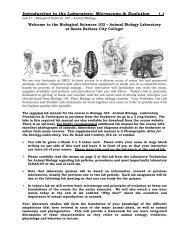Zoological Systematics & Taxonomy - Biosciweb.net
Zoological Systematics & Taxonomy - Biosciweb.net
Zoological Systematics & Taxonomy - Biosciweb.net
You also want an ePaper? Increase the reach of your titles
YUMPU automatically turns print PDFs into web optimized ePapers that Google loves.
<strong>Zoological</strong> <strong>Systematics</strong> & <strong>Taxonomy</strong> 3.1<br />
Lab #3 - Biological Sciences 102 – Animal Biology<br />
This lab is designed to introduce you to the basics of animal classification (systematics) and<br />
taxonomy of animals. This is a field that is constantly changing with the discovery of new<br />
animals, fossils, scientific techniques and the development of a better understanding of the<br />
evolutionary relationships between organisms.<br />
<strong>Systematics</strong> is the branch of biology that deals with the diversity of organisms in relation to<br />
their classification. Many biologists and textbooks do not clearly distinguish systematics from<br />
taxonomy. Thus, systematics is an umbrella term which can encompass many processes that<br />
describe species. There are at least three important disciplines which are united under this<br />
broad term. First there is the description of species (identification), there is the naming of<br />
names (taxonomy) and finally there is the description of the relationships among and between<br />
taxa (phyloge<strong>net</strong>ics).<br />
Basically, taxonomy involves the scientific naming of organisms and grouping or<br />
classifying of them with reference to their position in the kingdoms of life. More than 1.5<br />
million different species of animals have been classified on the basis of shared derived<br />
anatomical characters and biochemical procedures such as DNA hybridization, DNA<br />
microsatellite analyses, and DNA sequence analyses. Most of these species tend to fall into<br />
certain large groups because of similarities in structural organization. These primary groups<br />
are known as phyla (singular = phylum).<br />
How many different animal species currently live on Earth?<br />
This is not an easy question to answer. There are many regions of the pla<strong>net</strong> that are not wellexplored<br />
for animal life, in particular, the deep ocean. Some animal species are only found in<br />
very small areas (eg. less than one square kilometer or less), especially in the tropics.<br />
Estimates of the total number of all living species generally range from 10 to 100 million (with<br />
most estimates between 10 and 20 million). More than 1.5 million animals have been<br />
identified and named with most animals being insects and microscopic life forms. We may<br />
never know how many different animals there are because many of them have and will become<br />
extinct before being counted and described. Some zoologists estimate that less than 20% of all<br />
living animals and less than 1% of animals that existed in the past have been named.<br />
The tremendous diversity in life today is not new to our pla<strong>net</strong>. The noted evolutionary<br />
biologist Stephen Jay Gould estimated that 99% of all plant and animal species that have<br />
existed have already become extinct with most leaving no fossils. Also, realize that humans<br />
and other large animals are freakishly rare life forms, since 99% of all known animal species<br />
are smaller than bumble bees.<br />
Linnaeus and Some History of Classification<br />
Biologists use a variety of scientific techniques to classify organisms into different categories.<br />
Most of these procedures judge the varying degrees of apparent similarity and difference that<br />
they can see from the macroscopic to the microscopic to the molecular level. The assumption<br />
is that the greater the degree of similarity, the closer the biological and potentially the<br />
evolutionary relationship.
<strong>Zoological</strong> <strong>Systematics</strong> & <strong>Taxonomy</strong> 3.2<br />
Lab #3 - Biological Sciences 102 – Animal Biology<br />
Today many scientific techniques are used to determine phyloge<strong>net</strong>ic relationships between<br />
organisms and establish taxonomy of an animal including:<br />
‣ comparative anatomy or comparative morphology = examines the various shapes<br />
and sizes of organismal structures, organ systems and their development<br />
‣ comparative embryology = describes similarities and differences in animal<br />
development patterns, structures and timing of developmental events<br />
‣ comparative cytology = looks at variations in cell structures and the number, size and<br />
shape of chromosomes<br />
‣ comparative biochemistry = compares the amino acid sequences of proteins and<br />
nucleotide sequences of DNA<br />
Before the advent of modern, ge<strong>net</strong>ically based evolutionary studies, European and American<br />
biology consisted primarily of taxonomy, or classification of organisms into different categories<br />
based on their physical characteristics. The leading naturalists of the 18 th and 19 th centuries<br />
spent their lives identifying and naming newly discovered plants and animals. However, few of<br />
them asked what accounted for the patterns of similarities and differences between the<br />
organisms. This basically non-speculative approach is not surprising since most naturalists<br />
two centuries ago held the view that plants and animals had been created in their present form<br />
and that they have remained unchanged. As a result, it made no sense to ask how organisms<br />
have evolved through time. Similarly, for these early taxonomists, it was inconceivable that<br />
two animals or plants may have had a common ancestor or that extinct species may have been<br />
ancestors of modern ones.<br />
One of the most important 18th century naturalists was a Swedish botanist and medical doctor<br />
named Carl von Linné (1707-1778). He wrote 180 books mainly describing plant species in<br />
extreme detail. Since his published writings were mostly in Latin, he is known to the scientific<br />
world today as Carolus Linnaeus, which is the Latinized form he chose for his name.<br />
For more biographical information on Linnaeus, review the UC Museum of Paleontology<br />
at UC Berkeley website at http://www.ucmp.berkeley.edu/history/linnaeus.html.<br />
Although fundamental classification of animals may predate civilization, the questions of how<br />
classifications are to be constructed are by no means settled. Linnaeus, in 1735, published<br />
Systema Naturae. This marks the beginning of the modern classification of plants and<br />
animals. He devised practical techniques for the naming of groups of organisms and their<br />
ranking and ordering. He developed the system of binomial nomenclature that we still use<br />
today. In the modern world there are numerous philosophies and methods of classification<br />
which are in use and help add to the overall completeness and confusion in the world of<br />
taxonomy. Linnaeus' great contribution was to provide order in the method used in the<br />
classification of living organisms. This Linnaean system of classification was widely accepted<br />
by the early 19th century and is still the basic framework for all taxonomy in the biological<br />
sciences today.<br />
The Linnaean system uses two Latin name categories, genus and species, to designate each<br />
type of organism. A genus is a higher level category that includes one or more species under<br />
it. Such a dual level designation is referred to as a binomial nomenclature or binomen<br />
(literally "two names" in Latin). For example, Linnaeus described humans in his system with<br />
the binomen Homo sapiens, or "man who is wise". Homo is our genus and sapiens is our<br />
species.<br />
Linnaeus also created higher, more inclusive classification categories. For instance, he placed<br />
all monkeys and apes along with humans into the order Primates. His use of the word<br />
Primates (from the Latin primus meaning "first") reflects the human centered world view of<br />
Western science during the 18th century. While it implies that humans were "created" first, it
<strong>Zoological</strong> <strong>Systematics</strong> & <strong>Taxonomy</strong> 3.3<br />
Lab #3 - Biological Sciences 102 – Animal Biology<br />
also indicates that people are animals. In terms of our modern understanding of evolution, the<br />
term “primates” is quite anthropomorphically centric.<br />
While the form of the Linnaean classification system remains<br />
substantially the same, the reasoning behind it has undergone<br />
considerable change. For Linnaeus and his contemporaries,<br />
taxonomy served to demonstrate the unchanging order inherent in<br />
the natural world.<br />
This static view of nature was overturned in science by the middle<br />
of the 19th century by a small number of radical naturalists, most<br />
notably Charles Darwin. They provided some of the first conclusive<br />
evidence that evolution of life forms has occurred. In addition,<br />
Darwin and Wallace proposed natural selection as the mechanism<br />
responsible for these changes.<br />
Late in his life, Linnaeus also began to have some doubts about species being unchanging.<br />
Crossbreeding resulting in new varieties of plants suggested to him that life forms could<br />
change somewhat. However, he stopped short of accepting the evolution of one species into<br />
another.<br />
How Zoologists and Taxonomists Classify Animals<br />
On discovering an unknown organism, researchers begin their classification by looking for<br />
anatomical features that appear to have the same function as those found on other species.<br />
The next step is determining whether or not the similarities are due to an independent<br />
evolutionary development or due to descent from a common ancestor. If the latter is the case,<br />
then the two species are probably closely related and should be classified into the same or near<br />
biological categories.<br />
How does one identify an unknown specimen? One way is by direct comparison with<br />
specimens in a museum reference collection. However, few biologists have ready access to<br />
such collections and if they do the collections are often incomplete. Even with such access,<br />
most non-specialists would find this a tedious approach, involving working through thousands<br />
of museum specimens. In fact, this is part of the foundation of the field of taxonomy. In order<br />
for scientists and museums to organize their collections, a set of standards was necessary to<br />
make sense of the incredible diversity of organisms as well as for effective communication<br />
between biologists.<br />
A practical alternative is to use a taxonomic key. A key is a convenient tabular device that<br />
enables us to identify a specimen by comparing it feature by feature with alternatives given in<br />
key couplets. Keys may be designed to identify species, genera, families, orders, or any other<br />
taxon. You will work with a basic taxonomic key as part of today’s lab.<br />
Phyloge<strong>net</strong>ic analysis of a species involves a number of important concepts:<br />
Homologies are anatomical features or characters, of different organisms, that have a similar<br />
appearance or function because they were inherited from a common ancestor that also had<br />
them. A character is any feature that the taxonomist uses to study variation within and<br />
among species. For instance, the forelimb of a bear, the wing of a bird, and your arm have the<br />
same functional types of bones as did our shared ancestor. Therefore, these bones are<br />
homologous structures. The more homologies two organisms possess, the more likely it is that<br />
they have a close ge<strong>net</strong>ic relationship.
<strong>Zoological</strong> <strong>Systematics</strong> & <strong>Taxonomy</strong> 3.4<br />
Lab #3 - Biological Sciences 102 – Animal Biology<br />
There can also be non-homologous structural similarities between species. In these cases, the<br />
common ancestor did not have the same anatomical structures as its descendants. Instead,<br />
the similarities are due to independent development in the now separate evolutionary lines.<br />
Such misleading similarities are called homoplasies.<br />
Homoplastic structures can be the result of parallelism, convergence, analogies, or mere<br />
chance.<br />
Parallelism, or parallel evolution, is a similar evolutionary development in different species<br />
lines after divergence from a common ancestor that had the initial anatomical feature that<br />
led to it. For instance, some South American and African monkeys evolved relatively large<br />
body sizes independently of each other. Their common ancestor was a much smaller monkey<br />
but was otherwise reminiscent of the later descendant species. Apparently, nature selected for<br />
larger monkey bodies on both continents during the last 30 million years.<br />
Convergence, or convergent evolution, is the development of a similar anatomical feature in<br />
distinct species lines after divergence from a common ancestor that did not have the initial<br />
trait that led to it. The common ancestor is more distant in time than is the case with<br />
parallelism. The similar appearance and predatory behavior of North American wolves and<br />
Tasmanian wolves is an example. The former is a placental mammal and the latter is an<br />
Australian pouched marsupial. Their common ancestor lived during the age of the dinosaurs<br />
more than 100 million years ago and was very different from these descendants today. There<br />
are, in fact, a number of other Australian marsupials that are striking examples of convergent<br />
evolution with placental mammal elsewhere.<br />
Both parallelism and convergence are thought to be due primarily to separate species<br />
lines experiencing the same kinds of natural selection pressures over long periods of<br />
time.<br />
Analogies are anatomical features that have the same form or function in different species that<br />
have no known common ancestor. For instance, the wings of a bird and a butterfly are<br />
analogous structures because they are superficially similar in shape and function. Both of<br />
these very distinct species lines utilize wings to get off of the ground. However, as we will see,<br />
their wings are quite different.<br />
Most researchers today make a distinction between derived and primitive traits (characters)<br />
when they evaluate the importance of homologies for determining placement of organisms<br />
within the Linnaean classification system. Derived traits are those that have changed from the<br />
ancestral form and/or function. An example is the foot of a modern horse. Its distant early<br />
mammal ancestor had five digits. The bones of these digits have been largely fused together in<br />
horses giving them essentially only one toe with a hoof. In contrast, primates have retained the<br />
primitive characteristic of having five digits on the ends of their hands and feet. Animals<br />
sharing homologies that are derived, rather than only ancestral, are more likely to have<br />
a recent common ancestor. This assumption is the basis of the approach to classifying<br />
known as cladistics. Cladistics is a method of analyzing the evolutionary relationships<br />
between groups to construct their family (evolutionary) tree.<br />
It is also important to realize that most species are physically and ge<strong>net</strong>ically diverse. Many are<br />
far more varied than humans. When you think of an animal, such as a giraffe, and describe it<br />
in terms of its specific traits (coat color patterns, body shape, etc.), it is natural to generalize<br />
and to think of all giraffes that way. To do so, however, is to ignore incredible diversity of<br />
individuals within a population of animals. This variation is a foundation of evolution.
<strong>Zoological</strong> <strong>Systematics</strong> & <strong>Taxonomy</strong> 3.5<br />
Lab #3 - Biological Sciences 102 – Animal Biology<br />
International Code of <strong>Zoological</strong> Nomenclature (ICZN)<br />
Without a set of international rules to follow, the results of taxonomy would be confusing at<br />
best. The rules of zoological nomenclature are contained in a document known as the<br />
International Code of <strong>Zoological</strong> Nomenclature (ICZN). The object of the code is to promote<br />
stability and universality in the scientific names of animals. All names must be unique,<br />
universal, and show stability.<br />
Uniqueness<br />
Every name has to be unique. If several names have been given to the same taxon, priority<br />
decides which name will be the valid name.<br />
Universality<br />
Zoologists have adopted, by international agreement, a single language to be used on a<br />
worldwide basis. All animals are given a generic and specific name in Latin. These names are<br />
in italics or are underlined (i.e. Homo sapiens).<br />
Stability<br />
The ICZN attempts to prevent the frequent changing of names to provide stability.<br />
The names of genera are required by the rules of nomenclature to be unique. But such rules<br />
do not apply to other taxa, even though duplicate names should be avoided.<br />
A category designates a given rank or level in a hierarchic classification. Such terms as<br />
species, genus, family, and order designate categories.<br />
Organisms, in turn, are not classified as individuals, but as groups of organisms. Words like<br />
"bluebirds" or "thrushes" refer to such groups. Any such group of populations is called a<br />
taxon if it is considered distinct to be worthy of being formally assigned to a definite category<br />
in the hierarchic classification.<br />
Categories, which designate rank in a hierarchy, and taxa (singular = taxon), which<br />
designates named groupings of organisms, are thus different. Significant controversy usually<br />
occurs over whether or not a particular group is truly distinct enough to be a new taxon. If it is<br />
a new taxon, taxonomists then determine which category the taxon will be placed in.<br />
Much of the task of the taxonomist consists of assigning taxa to the appropriate<br />
categorical rank. The hierarchy of categories that the classifying taxonomist recognizes is an<br />
attempt to express similarity (characters shared in common) and recency of common descent.<br />
The most closely related species (occasionally subject to intense debate) are combined into<br />
genera, groups of related genera into subfamilies and families, these into orders, classes, and<br />
phyla.<br />
Type specimens are selected by the taxonomist to designate individuals which typify the<br />
described species. Type specimens are placed in museums for study by taxonomists.<br />
Often the type specimen does not represent all the variation within a species (this is often<br />
nearly impossible). The type specimen becomes the name bearer of the species. These terms<br />
relate to type specimens:<br />
Holotype = the single specimen indicated as "the type" by the original author at time of<br />
publication of the original description.<br />
Syntype = one of two or more specimens cited by the author of a species when no holotype was<br />
designated or it is any one of two or more specimens originally designated as types.<br />
Isotype = a duplicate specimen of the holotype collected at the same place and time as the<br />
holotype.<br />
Neotype = a specimen selected as type subsequent to the original description in cases where<br />
the original types are known to be destroyed.
<strong>Zoological</strong> <strong>Systematics</strong> & <strong>Taxonomy</strong> 3.6<br />
Lab #3 - Biological Sciences 102 – Animal Biology<br />
Binomial Nomenclature<br />
A species is a distinctive kind of living thing. There are many definitions of what kind of unit a<br />
species is (or should be). A common definition is that a species is a group of organisms<br />
capable of interbreeding and producing fertile offspring, and separated from other such<br />
groups with which interbreeding does not (normally) happen. Other definitions may focus on<br />
similarity of DNA or morphology. Some species are further subdivided into subspecies, there is<br />
no close agreement on the criteria to be used. The species, or scientific, name is a binomial<br />
- that is, it consists of two parts, a genus name and a species epithet. We call this twoname<br />
system the Linnaean system of binomial nomenclature. The human species is Homo<br />
sapiens; Homo ("a man") is the genus and sapiens ("mighty" or "wise") is the species epithet,<br />
actually an adjective that modifies the genus name. The genus name can be used alone when<br />
one is referring to a group of species included in that genus, such as Rana (a large genus of<br />
frogs) or Felis (a genus of cats, including wild and domestic species). The specific epithet,<br />
however, would be meaningless if used alone because the same epithet may be used in<br />
combination with different genera. The domestic cat is designated Felis domestica; domestica<br />
used alone is without significance, since it is a commonly used epithet that identifies no<br />
particular organism. Therefore, the species epithet must always be preceded by the genus<br />
name. However, you can abbreviate the genus name when it is used in a context in which it is<br />
understood. Felis domestica might then be designated F. domestica.<br />
Scientific names are always Latinized and are recognized internationally. This tends to prevent<br />
confusion, for although one animal may be called by several different common names in<br />
different geographical areas, its scientific name is the same the world over.<br />
The Integrated Taxonomic Information System (ITIS) – www.itis.gov<br />
The ITIS is the result of a partnership of federal agencies formed to satisfy their mutual needs<br />
for scientifically credible taxonomic information. Since its inception, ITIS has gained valuable<br />
new partners and undergone a name change; ITIS now stands for the Integrated Taxonomic<br />
Information System. The goal is to create an easily accessible database with reliable<br />
information on species names and their hierarchical classification. The database is reviewed<br />
periodically to ensure high quality with valid classifications, revisions, and additions of newly<br />
described species. The ITIS includes documented taxonomic information of flora and fauna<br />
from both aquatic and terrestrial habitats. Please go to www.itis.gov and peruse the<br />
website.<br />
Major Taxonomic Divisions of Life<br />
Important Formatting Note:<br />
Be aware that all taxa except the species and subspecies epithets are capitalized;<br />
species and subspecies epithets begin with lowercase letters. Genus, species, and<br />
subspecies names are printed in italics or are underlined when written or typed. For a<br />
complete scientific name of an animal species, both genus and species must be listed.<br />
Kingdom<br />
At this level, organisms are distinguished on the basis of cellular organization and methods of<br />
nutrition.<br />
Phylum<br />
Members of a phylum share specific distinctive body plan characteristics that set members of<br />
that group apart from all other members of the animal kingdom.<br />
In traditional Linnaean classification, a phylum is subdivided into smaller groups called<br />
classes; classes are further subdivided into orders; orders into families; families into genera<br />
(sing. genus); and genera into species (sing. and pl.). In large groups, other categories, such as<br />
superclass, suborder, infraorder, and subfamily, also exist.<br />
Class<br />
The living classes of vertebrates and invertebrates are distinguished mostly on the basis of<br />
their organ systems, general environmental adaptation, and reproductive strategies.
<strong>Zoological</strong> <strong>Systematics</strong> & <strong>Taxonomy</strong> 3.7<br />
Lab #3 - Biological Sciences 102 – Animal Biology<br />
Important Terms<br />
classification = The arranging of groups of organisms into sets or divisions on the basis of<br />
their evolutionary relationships.<br />
taxonomy = The theory and practice of describing, naming and classifying organisms.<br />
cladistics = A method of inferring evolutionary ancestry by methodically comparing possible<br />
evolutionary relationships between organisms and selecting as most likely the relationships<br />
which require, for instance, the fewest number of evolutionary transformations between<br />
character states.<br />
phylogeny = The evolutionary development and history of a species or higher taxonomic<br />
grouping of organisms.<br />
Systematic = The branch of biology that deals with the diversity of organisms in relation to<br />
their classification. Note: in some books, this term is not distinguished from taxonomy. This is<br />
an umbrella term to describe the processes that describe species. There are three disciplines<br />
which are united under this broad term. First there is the description of species<br />
(identification), then there is the naming of names (taxonomy) and then there is the description<br />
of the relationships among and between taxa (phyloge<strong>net</strong>ics).<br />
animal = An often mobile (although not always), multicellular eukaryotic heterotroph<br />
with internal digestion that develops from a blastula. Most animals take food molecules<br />
into their bodies to be digested by eating other organisms (internal digestion). Animals have<br />
unique embryonic stages (blastula & gastrula) with distinct layers of cells (ectoderm,<br />
mesoderm, endoderm). Animals are classified into the Kingdom Animalia.<br />
invertebrate = An animal that lacks a vertebral column (backbone) and cranium (skull).<br />
Sponges, cnidarians, flatworms, roundworms, molluscs, annelids, arthropods, echinoderms<br />
and many other animal types are invertebrates.<br />
vertebrate = An animal that has a vertebral column (backbone) and cranium (skull). All<br />
vertebrates are members of the Phylum Chordata.<br />
Important Animal Development Terms<br />
gastrula = The embryonic stage resulting from the division of the early cells into three<br />
major tissue types during early animal development. The gastrula has three tissue layers,<br />
the ectoderm, mesoderm, and endoderm. The gastrula forms from the blastula.<br />
gastrulation = The formation of a gastrula.<br />
ectoderm = The outer layer of three embryonic cell layers in a gastrula; forms the skin of<br />
the gastrula and gives rise to the epidermis, epidermal glands and nervous system of the adult.<br />
mesoderm = The middle layer of the three embryonic cell layers in a gastrula; gives rise to<br />
connective tissues such as bone, blood, the dermis of the skin, muscle and parts of many other<br />
organs in the adult.<br />
endoderm = The innermost of three embryonic cell layers in a gastrula; forms the gut of the<br />
gastrula and gives rise to the innermost linings of the digestive tract, other hollow organs and<br />
parts of many internal organs.
<strong>Zoological</strong> <strong>Systematics</strong> & <strong>Taxonomy</strong> 3.8<br />
Lab #3 - Biological Sciences 102 – Animal Biology<br />
LAB PROCEDURE<br />
NAME:<br />
LAB SCORE:<br />
Animals are classified into phyla (the taxa groups into which kingdoms are divided) based<br />
on the basic body plans including the presence of true tissues, type of body symmetry, the<br />
presence and type of an internal body cavity (coelom), segmentation, and cephalization.<br />
Displayed about the room are a few representative examples of most of the major animal phyla<br />
we will study throughout the semester. As you proceed through the lab, answer the questions<br />
about each group. Utilize your classmates, textbook, the Inter<strong>net</strong> and your instructor to work<br />
through the answers. You may also find the wallchart at the front of the room to be useful.<br />
The unknown specimens at the end will require you to use the Key to the Major Animal<br />
Taxa which will be distributed to you as a separate handout. At this point in the course, you<br />
may struggle to classify some animals into one of the groups indicated on this key, but by the<br />
end of the course you should have no difficulty in this task.<br />
‣ Use the labels next to the specimens to locate each of the following groups in the lab<br />
and then answer the questions.<br />
TRUE TISSUES<br />
A tissue is a collection of cells performing a similar function.<br />
Generally four basic types of tissues are recognized.<br />
(with many subtypes as we will see in later labs):<br />
1. Nervous tissue = uses electrical signals (potentials) to allow communication between cells<br />
2. Muscular tissue = electrical and contractile allowing for movement of cells/structures<br />
3. Connective tissue = holds other tissues types together into more complex tissues & organs<br />
4. Epithelial tissue = lines other tissues types such as the inside and outside of organs<br />
‣ Circle all of the animals below that possess true tissues.<br />
Kangaroo Rat Sea Anemone Sponge Dragonflies/Damselflies<br />
ANIMAL SYMMETRY<br />
1. RADIAL SYMMETRY<br />
Animals that can be divided into similar segments by more than two planes passing through<br />
one main axis (like a pie piece from a pie).<br />
2. BILATERAL SYMMETRY<br />
Animals that can be divided along a sagittal (between left and right) plane into two mirrored<br />
left and right halves. This was a major advancement as animals evolved the ability to do<br />
directional (forward) movement. There is now a front (anterior) and back (posterior) to the<br />
animal.<br />
‣ Write BILATERAL or RADIAL to indicate the symmetry of each of these animals.<br />
Scorpion<br />
Butterfly<br />
Sea Anemone<br />
Fish<br />
Sea Star<br />
Songbird
<strong>Zoological</strong> <strong>Systematics</strong> & <strong>Taxonomy</strong> 3.9<br />
Lab #3 - Biological Sciences 102 – Animal Biology<br />
EMBRYONIC DEVELOPMENT AND BODY CAVITIES<br />
The bilaterally symmetrical animals are further classified based on whether or not they<br />
possess a coelom.<br />
A coelom is an internal body cavity between the gut and the body wall lined with mesoderm.<br />
As the digestive system (gut) forms in animals with a true coelom, it may develop in one of<br />
two different ways. This determines if the animal is a protostome or a deuterostome.<br />
1. ACOELOMATE (ACOELOMIC ANIMAL)<br />
An animal with no body cavity (coelom) present.<br />
2. PSEUDOCOELOMATE (PSEUDOCOELOMIC ANIMAL)<br />
An animal with a “false coelom” or pseudocoel only lined with mesoderm on one side (near<br />
the ectoderm).<br />
3. EUCOELOMATE (EUCOELOMIC ANIMAL) or COELOMATE<br />
An animal with a “true coelom” lined with mesoderm on both sides (near both the<br />
endoderm and the ectoderm).<br />
Examine the three worm specimens and using your textbook and the Inter<strong>net</strong>, determine<br />
which label belongs with each animal and write it on the blank. The determination of<br />
coelom formation must be made by developmental and internal study of the individual<br />
animals. You cannot figure out the answer just by looking at the animals – look them up<br />
in the textbook or on the Inter<strong>net</strong>.<br />
‣ Indicate the type of coelom present in each worm.<br />
Nematode worm<br />
Flatworm<br />
Earthworm/Annelid<br />
DEUTEROSTOMES VERSUS PROTOSTOMES<br />
Bilateral animals diverged early in their evolution into two major and separate lineages;<br />
Protostomia (protostomes) & Deuterstomia (deuterostomes)<br />
PROTOSTOMES are a group of phyla in which the mouth forms first and then the anus forms<br />
as the gut develops. Protostomes are also schizocoelous with spiral cleavage patterns.<br />
DEUTEROSTOMES are a group of phyla in which the anus forms first and then the mouth<br />
forms as the gut develops. Deuterostomes are also enterocoelous with radial cleavage patterns.<br />
Examine the animal specimens and using your textbook and the Inter<strong>net</strong>, determine<br />
whether each animal is a protostome or deuterostome and write it on the blank. The<br />
determination of this characteristic must be made by developmental and internal study<br />
of the individual animals. You cannot figure out the answer just by looking at the<br />
animals – look them up in the textbook or on the Inter<strong>net</strong>.<br />
‣ Indicate whether each animal group is a PROTOSTOME or a DEUTEROSTOME.<br />
Sea Star or Sea Urchin<br />
Beetle<br />
Human
<strong>Zoological</strong> <strong>Systematics</strong> & <strong>Taxonomy</strong> 3.10<br />
Lab #3 - Biological Sciences 102 – Animal Biology<br />
METAMERISM (SEGMENTATION)<br />
Metamerism refers to the serial repetition of similar body segments along the longitudinal<br />
(long) axis of the body. Each segment is called a metamere or somite. In some animals the<br />
segmental arrangement includes both internal and external structures. In more evolved forms,<br />
the segmentation arrangement is not as clear (e.g. humans). Note that the segments do not<br />
need to look exactly the same as each other in order for an animal to be metameric<br />
(segmented).<br />
CEPHALIZATION<br />
The differentiation of a head with a concentration of nervous and sense organs primarily<br />
seen in bilaterally symmetrical animals. Cephalization evolved as directional movement<br />
evolved so animals could more effectively hunt prey and gather food.<br />
‣ Indicate if each of the following organisms is metameric (M) and/or cephalized (C) by<br />
placing an M and/or a C on the blank.<br />
Fish<br />
Nemertean (ribbonworm)<br />
Sea Urchin<br />
Crayfish<br />
Sea Mouse (polychaete worm)<br />
Bird<br />
Ascaris (roundworm)<br />
SKELETON TYPES<br />
Animals are further categorized based on the type of skeleton or protective structures they<br />
possess. Use your textbook and the Inter<strong>net</strong> to help you determine the basic differences in<br />
these types of skeletons.<br />
‣ Indicate if each of the following animals has a hydrostatic (write HYDRO), endoskeleton<br />
(write ENDO), exoskeleton (write EXO) and/or a shell (write SHELL). Note that some<br />
may have more than one skeleton type such as a shell and an endoskeleton.<br />
Indicate all skeleton types that apply to the animal.<br />
Polychaete worm<br />
Turtle<br />
Sea Slug<br />
Abalone<br />
Sea Urchin<br />
Clam<br />
Cockroach/Insect<br />
Snake<br />
Peanut worm<br />
Desert Tortoise<br />
Falconiform bird<br />
Lobster
<strong>Zoological</strong> <strong>Systematics</strong> & <strong>Taxonomy</strong> 3.11<br />
Lab #3 - Biological Sciences 102 – Animal Biology<br />
APPENDAGE TYPES<br />
Animals can also be classified based on the type of appendages they possess that are used for<br />
locomotion or feeding. Use your textbook and the Inter<strong>net</strong> to help you determine the<br />
basic differences in these types of appendages.<br />
‣ Indicate if each of the following animals has jointed legs (write JL), swimmerets<br />
(write S), fins (write F) and/or wings (write W). Note that some animals may have<br />
more than one type of appendage. Indicate all appendage types seen for each animal.<br />
Bat<br />
Shrimp<br />
Bird<br />
Fish<br />
Crab<br />
Insect<br />
Use of a Dichotomous Taxonomic Key<br />
Following is a brief exercise in classification that shows you how to use a taxonomic key<br />
to "run down" or "key out" the classification of an animal when neither its common nor<br />
its scientific name is known.<br />
You will be given a handout that is a simple key to the more common phyla and classes of<br />
animals and free-living protozoans. The key, for the most part, uses external characters<br />
that can be visualized without dissection. It is designed for use with adult specimens. Like<br />
most keys, this key is utilitarian in the sense that the animal groups are not arranged in<br />
perfect phyloge<strong>net</strong>ic sequence, and the characters used in the key may have no particular<br />
phyloge<strong>net</strong>ic significance for the taxon. They are simply the characters that typically<br />
provide the best assurance of correct identification.<br />
A two-choice system serves as the basis of a dichotomous key. In the dichotomous key, two<br />
contrasting alternatives are offered at once, so you can choose the one that fits your specimen.<br />
At the end of the choice, you will find a reference number to the next set of alternatives to be<br />
considered. Again make a decision and proceed in the same manner until you arrive at the<br />
scientific name of the animal or the taxon to which it belongs.<br />
This key also has the capacity for reverse use so that you can retrace your steps if you make a<br />
mistake. In each couplet, the number in parentheses refers to the number of the couplet from<br />
which that couplet was reached.<br />
Keep in mind that individual variations exist; keys are based on the average, or "typical," adult<br />
specimen, whereas your specimen may be immature or somewhat abnormal. It is often very<br />
helpful to examine more than one specimen of a species or group, if available, when a<br />
particular descriptive character proves troublesome.
<strong>Zoological</strong> <strong>Systematics</strong> & <strong>Taxonomy</strong> 3.12<br />
Lab #3 - Biological Sciences 102 – Animal Biology<br />
CLASSIFICATION PRACTICE<br />
Utilize the key to classify the following animals:<br />
Indicate phylum and if possible class<br />
Butterfly<br />
Earthworm<br />
Frog<br />
Jellyfish<br />
Sea Star<br />
Clam<br />
Crab<br />
Sheep Liver Fluke<br />
UNKNOWN ANIMAL SPECIMENS<br />
As time permits, utilize the key to classify the following unknown specimens:<br />
Indicate phylum and if possible class<br />
1.<br />
2.<br />
3.<br />
4.<br />
5.<br />
6.<br />
7.<br />
8.<br />
9.<br />
10.<br />
11.<br />
12.<br />
13.<br />
14.<br />
15.
<strong>Zoological</strong> <strong>Systematics</strong> & <strong>Taxonomy</strong> 3.13<br />
Lab #3 - Biological Sciences 102 – Animal Biology<br />
LABORATORY NOTES:
<strong>Zoological</strong> <strong>Systematics</strong> & <strong>Taxonomy</strong> 3.14<br />
Lab #3 - Biological Sciences 102 – Animal Biology<br />
LABORATORY NOTES:<br />
Ape Skeletons – Can you name the primate based on their skeleton only?<br />
Which skeleton is from a gorilla, gibbon, chimpanzee, human, or orangutan?



